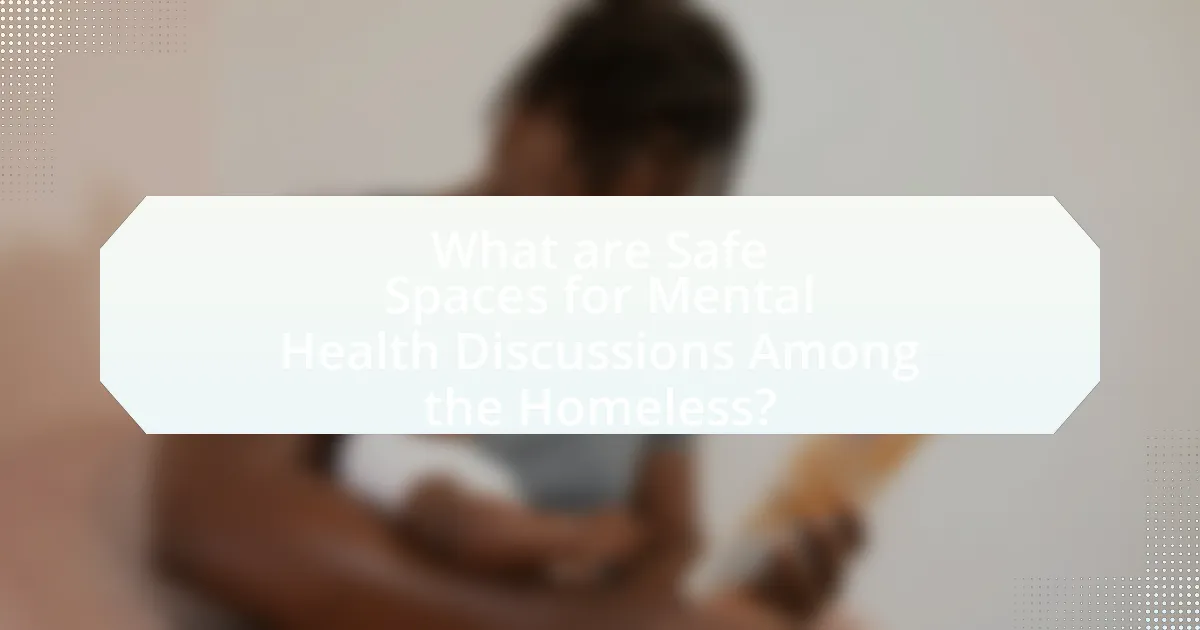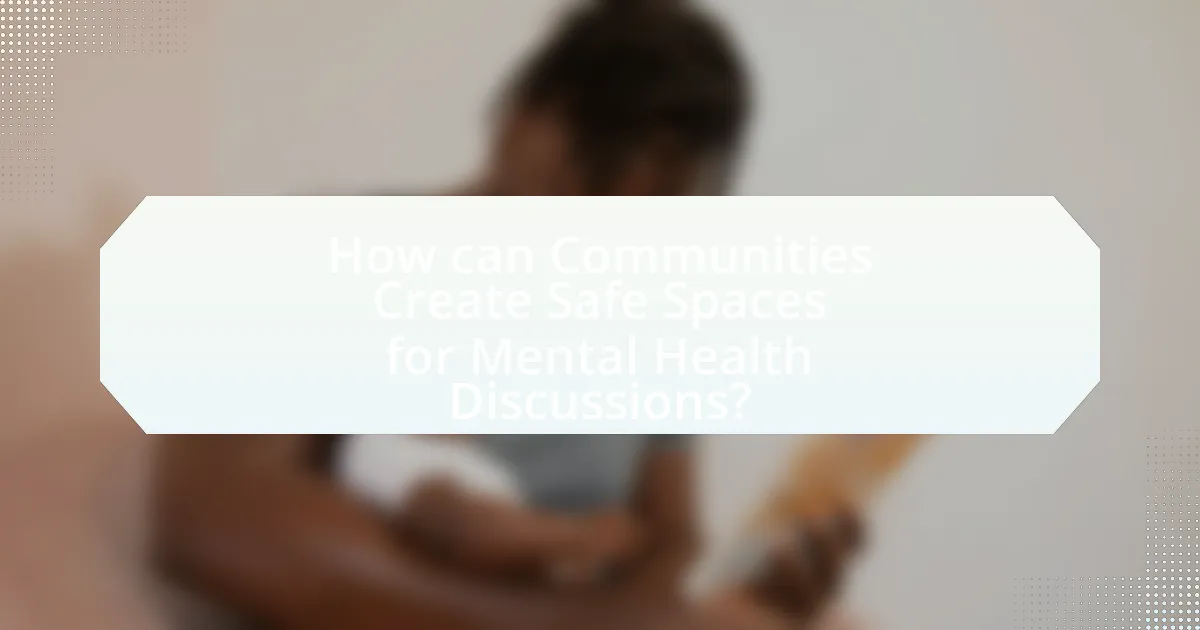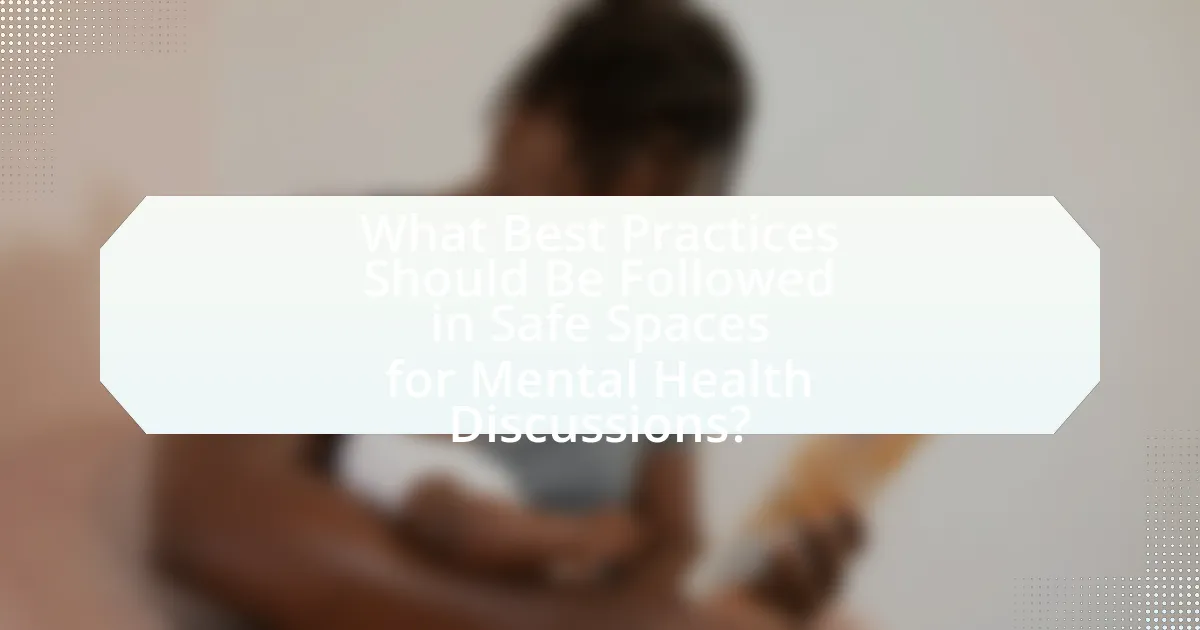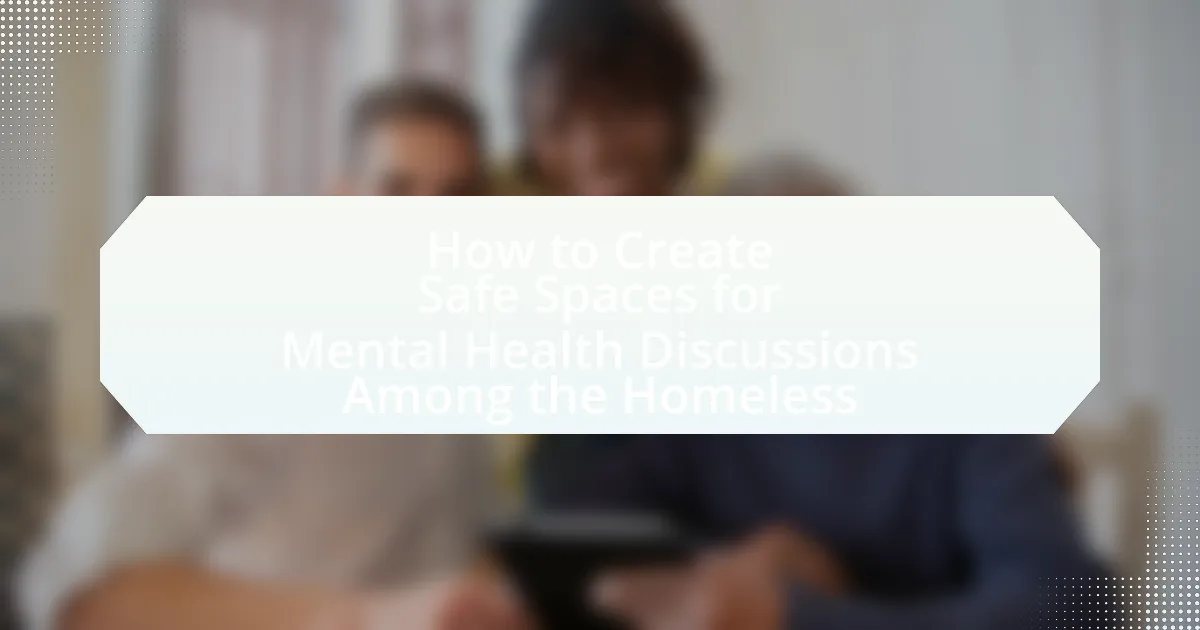Safe spaces for mental health discussions among the homeless are designated environments that allow individuals experiencing homelessness to share their mental health challenges without fear of judgment. These spaces are characterized by confidentiality, respect, and non-judgmental attitudes, which foster trust and open dialogue. The article explores how safe spaces contribute to mental health awareness, the challenges faced by homeless individuals in discussing mental health, and the strategies communities can implement to create and sustain these supportive environments. It also highlights the importance of trained facilitators, outreach efforts, and community involvement in enhancing participation and improving mental health outcomes for this vulnerable population.

What are Safe Spaces for Mental Health Discussions Among the Homeless?
Safe spaces for mental health discussions among the homeless are designated environments where individuals experiencing homelessness can openly share their mental health challenges without fear of judgment or stigma. These spaces often provide supportive resources, such as trained facilitators or mental health professionals, who create a trusting atmosphere conducive to honest dialogue. Research indicates that such environments can significantly improve mental health outcomes by fostering community support and reducing feelings of isolation, which are prevalent among homeless populations.
How do safe spaces contribute to mental health awareness among the homeless?
Safe spaces contribute to mental health awareness among the homeless by providing a supportive environment where individuals can openly discuss their mental health challenges without fear of judgment. These spaces facilitate access to mental health resources, education, and peer support, which are crucial for increasing awareness and understanding of mental health issues. Research indicates that when homeless individuals engage in discussions about mental health in safe spaces, they are more likely to recognize their own mental health needs and seek help. For example, a study published in the Journal of Social Issues found that peer-led support groups in safe spaces significantly improved participants’ knowledge about mental health and available services, leading to increased utilization of mental health resources.
What characteristics define a safe space for mental health discussions?
A safe space for mental health discussions is characterized by confidentiality, respect, and non-judgmental attitudes. Confidentiality ensures that participants feel secure sharing personal experiences without fear of exposure, which is crucial for fostering trust. Respect involves acknowledging diverse perspectives and experiences, creating an inclusive environment where everyone feels valued. Non-judgmental attitudes allow individuals to express their feelings freely, promoting open dialogue. Research indicates that environments with these characteristics significantly enhance the willingness of individuals, particularly marginalized groups like the homeless, to engage in mental health discussions, leading to better support and outcomes.
Why is it important to create safe spaces specifically for the homeless population?
Creating safe spaces specifically for the homeless population is crucial for fostering mental health and well-being. These environments provide individuals experiencing homelessness with a sense of security and belonging, which is essential for addressing their mental health needs. Research indicates that safe spaces can reduce feelings of isolation and anxiety, allowing for open discussions about mental health challenges. For instance, a study published in the American Journal of Public Health found that supportive environments significantly improve mental health outcomes among marginalized groups, including the homeless. By establishing safe spaces, communities can facilitate access to resources, support networks, and mental health services, ultimately promoting recovery and resilience among homeless individuals.
What challenges do homeless individuals face in discussing mental health?
Homeless individuals face significant challenges in discussing mental health, primarily due to stigma, lack of trust, and limited access to mental health resources. Stigma surrounding mental health can lead to feelings of shame and fear of judgment, making individuals reluctant to share their experiences. Additionally, many homeless individuals have experienced trauma and may struggle to trust others, including mental health professionals, which hinders open communication. Furthermore, the lack of access to mental health services, exacerbated by their living conditions, limits opportunities for these discussions. According to the National Coalition for the Homeless, approximately 20-25% of the homeless population suffers from severe mental illness, highlighting the urgent need for supportive environments where they can safely discuss their mental health challenges.
How do stigma and discrimination affect mental health discussions among the homeless?
Stigma and discrimination significantly hinder mental health discussions among the homeless by fostering an environment of fear and mistrust. This population often experiences negative stereotypes that portray them as dangerous or irresponsible, leading to reluctance in seeking help or discussing mental health issues openly. Research indicates that 70% of homeless individuals report feeling judged or discriminated against when accessing mental health services, which exacerbates feelings of isolation and hopelessness. Consequently, the pervasive stigma surrounding mental illness and homelessness creates barriers to effective communication, ultimately preventing individuals from receiving the support they need.
What barriers prevent homeless individuals from accessing mental health resources?
Barriers preventing homeless individuals from accessing mental health resources include lack of transportation, financial constraints, and stigma. Transportation issues hinder their ability to reach facilities, as many do not have reliable means to travel. Financial constraints limit access to services, as many mental health resources may not be affordable or covered by insurance. Stigma surrounding mental health can discourage individuals from seeking help, as they may fear judgment or discrimination. According to the National Alliance on Mental Illness, approximately 20% of homeless individuals experience severe mental illness, yet only a fraction receive the necessary care due to these barriers.

How can Communities Create Safe Spaces for Mental Health Discussions?
Communities can create safe spaces for mental health discussions by establishing dedicated venues where individuals feel secure and supported. These venues should prioritize confidentiality, ensuring that participants can share their experiences without fear of judgment or stigma. Research indicates that environments fostering trust and openness significantly enhance the willingness of individuals to engage in mental health conversations. For instance, a study published in the Journal of Community Psychology highlights that peer-led support groups effectively reduce feelings of isolation among participants, thereby promoting mental well-being. Additionally, training facilitators in active listening and empathy can further reinforce a supportive atmosphere, making it easier for individuals to express their thoughts and feelings.
What strategies can be implemented to establish safe spaces?
To establish safe spaces for mental health discussions among the homeless, organizations can implement strategies such as creating inclusive environments, providing trained facilitators, and ensuring confidentiality. Inclusive environments can be fostered by designing spaces that are physically accessible and welcoming, which encourages participation from individuals experiencing homelessness. Trained facilitators play a crucial role in guiding discussions, as they can help manage sensitive topics and ensure that all voices are heard, thereby promoting trust and openness. Ensuring confidentiality is vital, as it protects participants’ privacy and encourages them to share their experiences without fear of judgment or repercussions. These strategies are supported by research indicating that safe spaces significantly improve mental health outcomes by fostering community support and reducing stigma.
How can local organizations collaborate to create effective safe spaces?
Local organizations can collaborate to create effective safe spaces by establishing partnerships that leverage their unique resources and expertise. For instance, mental health service providers can work with shelters and community centers to offer workshops and support groups tailored to the homeless population. Research indicates that collaborative efforts, such as those documented in the “Community-Based Participatory Research” by Israel et al. (2010), enhance trust and engagement, which are critical for creating safe environments. By sharing information, training staff, and co-hosting events, these organizations can foster a sense of belonging and security, ultimately improving mental health outcomes for individuals experiencing homelessness.
What role do trained facilitators play in these discussions?
Trained facilitators play a crucial role in mental health discussions among the homeless by guiding conversations, ensuring inclusivity, and fostering a safe environment. Their expertise allows them to navigate sensitive topics effectively, helping participants feel comfortable sharing their experiences. Research indicates that trained facilitators can enhance group dynamics and promote open dialogue, which is essential for addressing mental health issues in vulnerable populations. For instance, studies show that structured facilitation leads to increased participation and improved outcomes in group discussions, highlighting the importance of their role in creating supportive spaces.
How can outreach efforts enhance participation in safe spaces?
Outreach efforts can enhance participation in safe spaces by actively engaging marginalized communities and building trust. Effective outreach strategies, such as targeted communication and collaboration with local organizations, can inform individuals about the existence and benefits of safe spaces. For instance, studies show that outreach initiatives that include peer advocates significantly increase attendance rates, as they provide relatable support and reduce stigma associated with seeking help. Additionally, outreach can facilitate the creation of culturally relevant programming, which resonates more with the target audience, thereby fostering a sense of belonging and encouraging participation.
What methods can be used to raise awareness about safe spaces among the homeless?
To raise awareness about safe spaces among the homeless, community outreach programs can be implemented. These programs can include distributing informational flyers in shelters and food distribution centers, where homeless individuals frequently visit. Additionally, partnerships with local organizations, such as churches and non-profits, can facilitate workshops that educate both the homeless and the general public about the importance of safe spaces for mental health discussions. Research indicates that direct engagement through peer-led initiatives significantly increases awareness and participation, as seen in studies conducted by the National Alliance to End Homelessness, which highlight the effectiveness of community-driven approaches in reaching marginalized populations.
How can trust be built between facilitators and homeless individuals?
Trust can be built between facilitators and homeless individuals through consistent, respectful engagement and by demonstrating reliability. Facilitators should prioritize active listening, showing empathy, and maintaining confidentiality to create a safe environment. Research indicates that trust is fostered when individuals feel heard and valued; for instance, a study by the National Alliance to End Homelessness highlights that building rapport through regular interactions significantly enhances trust levels. Additionally, providing transparent information about available resources and support can further solidify this trust, as individuals are more likely to engage when they understand the intentions and capabilities of the facilitators.

What Best Practices Should Be Followed in Safe Spaces for Mental Health Discussions?
Best practices for safe spaces in mental health discussions include establishing confidentiality, fostering a non-judgmental environment, and ensuring accessibility. Confidentiality encourages participants to share openly without fear of repercussions, which is crucial for trust-building. A non-judgmental atmosphere allows individuals to express their feelings and experiences freely, promoting honest dialogue. Accessibility ensures that all individuals, particularly those experiencing homelessness, can participate without barriers, such as location or resource limitations. Research indicates that these practices significantly enhance the effectiveness of mental health discussions, as they create a supportive framework that encourages engagement and healing.
How can confidentiality be maintained in these discussions?
Confidentiality in discussions about mental health among the homeless can be maintained through strict adherence to privacy protocols and the establishment of trust. Implementing measures such as secure communication channels, ensuring that only authorized personnel are involved in discussions, and using anonymized data can significantly reduce the risk of information leaks. Research indicates that confidentiality is crucial for fostering an environment where individuals feel safe to share personal experiences; for instance, a study published in the Journal of Social Issues highlights that perceived confidentiality directly influences the willingness of homeless individuals to engage in mental health services.
What guidelines should be established to ensure respectful communication?
To ensure respectful communication, guidelines should include active listening, using inclusive language, and maintaining confidentiality. Active listening fosters understanding and shows respect for the speaker’s perspective, which is crucial in sensitive discussions about mental health. Using inclusive language avoids alienation and promotes a sense of belonging, particularly important in conversations involving marginalized groups like the homeless. Maintaining confidentiality protects individuals’ privacy and encourages open dialogue, as people are more likely to share personal experiences when they feel secure. These guidelines are supported by research indicating that respectful communication enhances trust and engagement in vulnerable populations, ultimately leading to more effective mental health support.
How can feedback from participants improve the effectiveness of safe spaces?
Feedback from participants can significantly enhance the effectiveness of safe spaces by identifying specific needs and preferences that shape the environment. When participants share their experiences and suggestions, facilitators can tailor the space to better address issues such as comfort, accessibility, and inclusivity. For instance, a study by the National Alliance to End Homelessness highlights that incorporating participant feedback leads to increased engagement and satisfaction, ultimately fostering a more supportive atmosphere for mental health discussions. This iterative process ensures that safe spaces evolve based on real user experiences, making them more relevant and effective for the homeless community.
What resources are available to support safe spaces for mental health discussions?
Resources available to support safe spaces for mental health discussions include community organizations, mental health hotlines, peer support groups, and online platforms. Community organizations such as the National Alliance on Mental Illness (NAMI) provide training and resources to facilitate discussions in safe environments. Mental health hotlines, like the National Suicide Prevention Lifeline, offer immediate support and guidance. Peer support groups, often facilitated by trained individuals with lived experience, create a non-judgmental space for sharing. Online platforms, such as forums and social media groups, allow for anonymous discussions, further enhancing safety and accessibility. These resources collectively foster an environment conducive to open and honest mental health conversations.
How can community members contribute to the sustainability of these spaces?
Community members can contribute to the sustainability of safe spaces for mental health discussions among the homeless by actively participating in and supporting these initiatives. Their involvement can include volunteering time to facilitate discussions, providing resources such as food or hygiene products, and advocating for policies that protect and promote these spaces. Research indicates that community engagement enhances the effectiveness of mental health programs, as seen in studies showing that peer support significantly improves mental health outcomes (Chinman et al., 2014, American Journal of Psychiatry). By fostering a sense of ownership and responsibility, community members help ensure these spaces remain accessible and effective for those in need.
What funding opportunities exist for organizations creating safe spaces?
Funding opportunities for organizations creating safe spaces include government grants, private foundations, and crowdfunding initiatives. For instance, the Substance Abuse and Mental Health Services Administration (SAMHSA) offers grants specifically aimed at improving mental health services, which can be utilized to establish safe spaces for discussions among the homeless. Additionally, organizations like the Robert Wood Johnson Foundation provide funding for projects that promote health equity, including mental health initiatives. Crowdfunding platforms such as GoFundMe also allow organizations to raise funds directly from the community to support their safe space initiatives. These funding sources are critical for enabling organizations to create and maintain environments conducive to mental health discussions.
What are practical tips for facilitating effective mental health discussions among the homeless?
To facilitate effective mental health discussions among the homeless, create a non-judgmental environment that encourages open communication. Establish trust by actively listening and showing empathy, which can significantly reduce barriers to sharing personal experiences. Use simple, clear language to ensure understanding, and avoid technical jargon that may alienate individuals. Incorporate peer support by involving individuals with lived experiences, as they can relate and foster a sense of community. Additionally, provide privacy during discussions to ensure confidentiality, which is crucial for building trust. Research indicates that supportive environments enhance engagement in mental health services, as seen in studies conducted by the National Alliance to End Homelessness, which highlight the importance of trust and community in mental health outreach.

Leave a Reply